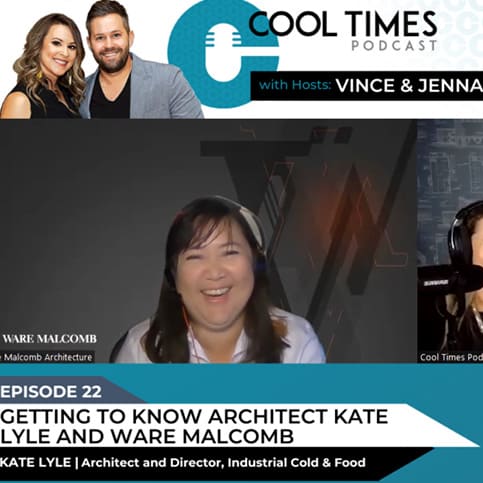I sat down to discuss new trends and technology on the Cool Times podcast. I specialize in complex project types including food processing, manufacturing, and cold storage. Although I joke my success in the industry is pure luck, I’m deeply passionate about innovation, often finding myself intrigued with tech-focused solutions that continue to push the bar on status quo cold building design. When considering where the cold storage industry is heading, it is evident that solutions focused on sustainability are at the forefront.
It’s important to highlight several new and reimagined processes that are quickly shifting the conversation around cold storage sustainability and architectural design innovation.
Going Vertical
A focus on vertical building concepts has started making a positive impact for both the client’s bottom line and the environment.
The shift to vertical pallet storage uses natural systems to cool the same number of pallets with less energy output overall. The concept of creating a vertical system also uses significantly less space than previous horizontal designs, eliminating potentially millions in square footage required for facilities.

Goodbye Freon
Another evolving aspect of refrigeration is the shift away from climate-disrupting chemicals. While previous refrigeration systems often relied on the use of freon, we are beginning to see a bigger reliance on both CO2 and ammonia to keep spaces cool.
Although these options don’t come without challenges, both CO2 and ammonia have low Global Warming Potential (GWP). Ammonia is a natural refrigerant that has long been used as a reliable refrigerant, making it an ideal option for large scale operations. More recently, CO2 has become a choice in many food processing, cold storage and commercial facilities without some of the regulatory obstacles attached to using ammonia. While neither has emerged as a clear front-runner, the elimination of freon is a step forward for sustainability.
Flexible Spaces
Refrigerated building design evolves to meet the demands of an ever-changing industry. This has prompted a recent push for more speculative cold storage solutions. The highly flexible spaces have created more cost and time-effective options for clients looking to occupy a building, while still accommodating custom solutions to meet the unique needs of each client.
Some design features of speculative cold storage include breaks in the roof structure to allow for multiple room configurations within large spaces. It’s important to emphasize the importance of installing freezer slabs as a default to prepare for all potential client needs – both now and in the future. Designing flexible facilities to adapt to various circumstances eliminates the needs for large structural changes down the road, cutting down on both costs and resources.
Despite the obstacles within an energy-reliant industry, our team continues to lay the groundwork for more sustainable cold building design solutions. By leaning into processes that take up less space, and rely on less energy output, we can continue to offer significant benefits for both a client’s bottom line and the environment.
Listen to the full interview on the Cool Times Podcast.

